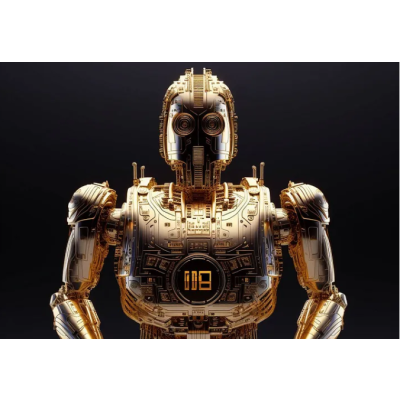

In the epoch of Bitcoin and NFTs, investors and aficionados alike are bracing themselves to ride the exhilarating wave of digital art. With the advent of OpenAI, the art of trading these unique digital assets is about to undergo a radical transformation. Envision an AI-driven trading bot that not only keeps tabs on the pulse of the ever-changing NFT landscape but is also capable of making calculated decisions, buying, selling, and swapping Bitcoin NFTs also known as oon Ord.io autonomously.
This new era of AI-fueled trading has the potential to change the way we interact with the growing NFT market. Bitcoin NFTs, already a buzzword in the digital asset sphere, are poised to become the focal point of this technological evolution. In this article, we will explore the intricacies of developing such a bot, making it capable of mining the web for data, analyzing trends, executing trades, and even sending timely notifications about its trades. Buckle up as we embark on this exciting journey, diving deep into the revolutionary merger of OpenAI, blockchain, and financial technology.
Bitcoin NFTs, also known as Ordinals, are a unique development in the digital asset landscape. NFTs, or Non-Fungible Tokens, have become a mainstream method of representing ownership of a unique item or piece of content on a blockchain. Unlike regular cryptocurrencies like Bitcoin and Ethereum which are fungible and identical to each other, NFTs are unique — each token has a distinct value and specific information that cannot be replicated.
Bitcoin, being the pioneer and most recognized cryptocurrency, was initially not designed with the capabilities to directly support NFTs due to its UTXO (unspent transaction output) model, unlike Ethereum that operates on an account/balance model that is more flexible for handling NFTs through the ERC-721 token standard.
OpenAI can be used to sift through the vast array of data available on the internet regarding NFT projects. By analyzing trends, media sentiment, and popularity metrics, OpenAI can help identify NFTs that are likely to increase in value or represent sound investments.
Here’s a Python snippet using OpenAI’s GPT-4 model to parse web data for NFT analysis:
import openai
openai.api_key = 'your-api-key'
def analyze_nft_projects():
documents = collect_web_data() # This function would collect and pre-process web data
analysis_results = []
for doc in documents:
response = openai.Answer.create(
engine="text-davinci-003",
documents=[doc],
question="What's the potential of this NFT project?",
)
analysis_results.append(response.choices[0].text.strip())
return analysis_resultsFor analyzing NFT prices, particularly Bitcoin NFTs on Ord.io, another Language Learning Model (LLM) can be beneficial. The second LLM could, for example, focus on understanding and interpreting financial data. Below is an illustration of how this might be implemented:
def analyze_nft_prices():
price_data = fetch_ordio_data() # This function would fetch and pre-process ord.io data
price_analysis_results = []
for data in price_data:
response = openai.Answer.create(
engine="text-davinci-003",
documents=[data],
question="What's the trend in this NFT's price?",
)
price_analysis_results.append(response.choices[0].text.strip())
return price_analysis_resultsNow, we integrate these analyses into a trading bot that can execute trades, swaps, and purchases from the creator’s ordinal wallet. This bot would analyze the data provided, make decisions on when to bid, purchase or offload an NFT, and execute those actions. Here’s a simplified example:
class TradingBot:
def __init__(self, wallet_address):
self.wallet = Wallet(wallet_address) # This is your Ord.io wallet
self.nft_projects_analysis = analyze_nft_projects()
self.nft_prices_analysis = analyze_nft_prices()
def decide_and_trade(self):
for project, price in zip(self.nft_projects_analysis, self.nft_prices_analysis):
decision = self.make_decision(project, price) # This function would use your custom decision-making algorithm
if decision == "buy":
self.buy_nft(project)
elif decision == "sell":
self.sell_nft(project)
def buy_nft(self, project):
# Implement the function to buy NFT from the creator's wallet
def sell_nft(self, project):
# Implement the function to sell or offload NFTAdding an email notification system helps keep you informed about the bot’s actions and decisions. Python’s smtplib can be used for this purpose:
import smtplib
from email.mime.multipart import MIMEMultipart
from email.mime.text import MIMEText
def send_email(subject, message):
msg = MIMEMultipart()
password = "your-email-password"
msg['From'] = "[email protected]"
msg['To'] = "[email protected]"
msg['Subject'] = subject
msg.attach(MIMEText(message, 'plain'))
server = smtplib.SMTP('smtp.gmail.com: 587')
server.starttls()
server.login(msg['From'], password)
server.sendmail(msg['From'], msg['To'], msg.as_string())
server.quit()You can call the send_email function whenever the bot makes a decision:
def decide_and_trade(self):
for project, price in zip(self.nft_projects_analysis, self.nft_prices_analysis):
decision = self.make_decision(project, price)
if decision == "buy":
self.buy_nft(project)
send_email("Bought NFT", f"Bought NFT: {project}")
elif decision == "sell":
self.sell_nft(project)
send_email("Sold NFT", f"Sold NFT: {project}")When developing your trading bot, remember to follow best practices:
In the confluence of blockchain, artificial intelligence, and machine learning, we’re charting a new course for Bitcoin NFT trading. Our journey with OpenAI and another LLM has revealed a promising pathway to creating a dynamic trading bot that can bravely navigate the unpredictable waters of NFT markets on Ord.io. We’ve explored the many facets of its design and functionality, from its analytical prowess to its autonomous decision-making capabilities and alert system.
By tapping into the pulse of trending Bitcoin NFTs, our bot embodies the zeitgeist of digital art trading. It’s not just a program, but a daring adventurer set forth into the exciting wilderness of digital art commerce. As we look towards the horizon, we can’t help but feel a sense of awe at the myriad possibilities that lie ahead.
But as we celebrate our innovative strides, we must also remain mindful. As we embrace the potential of this pioneering venture, it is crucial to remember the best practices and safeguards that ensure the viability and security of our digital endeavors.
Indeed, the fusion of these powerful technologies has opened up a new frontier in NFT trading. Yet, as with all adventures, it’s the thrill of exploration and the pursuit of discovery that fuels our passion. So, to all our fellow explorers at the intersection of AI and blockchain technology, we say: let the trading begin, and may the winds of innovation propel us towards exciting new territories in the realm of Bitcoin NFTs.